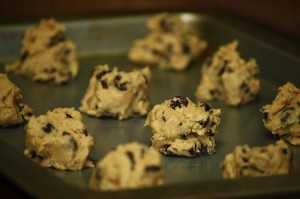Food safety isn’t dogmatic, it’s based on risk, the product of the likelihood of the hazard and severity of an illness. L.V. Anderson of Slate tackles risk as it relates to raw eggs in homemade cookie dough. She makes the case that the chance of Salmonella in eggs is relatively low (1 in 20,000 eggs) and many egg-related illnesses are linked to pooled and/or temperature abused eggs (see Australia). 
Every time I have made a type of cake or cookie for the recipe column I write for Slate, I’ve unfailingly consumed some of the uncooked mixture. Heck, every time I’ve made a type of cake or cookie just for fun, I’ve unfailingly consumed some of the uncooked mixture. And I have never in my 27 years gotten salmonella poisoning.
A quick back-of-the-envelope calculation: I estimate that I’ve baked cookies, cake, or brownies once a month, on average, since I started baking by myself around the age of 12 and that I have tasted the dough or batter every time. Let’s say that each of those batches of cookies, cake, or brownies has contained two eggs—a conservative estimate. This means that I have ingested the innards of—at the very least—360 uncooked eggs in my life.
Using data from the 1990s, the Centers for Disease Control and Prevention estimate that one in 20,000 eggs is internally contaminated with salmonella. Since salmonella prevention practices have improved since then, the egg contamination rate is probably even lower now.
Speaking personally, the statistics haven’t scared me off unpasteurized eggs for good. If I continued consuming batter and dough containing about two raw eggs per month, I would likely encounter only one SE-contaminated egg over the course of 833 years. And if I remain generally healthy, I might not even get sick from that SE-contaminated egg. Of course, by the time I’m 860, my immune system will probably be weak enough that I’ll want to avoid unpasteurized eggs. In the meantime, though, I’ll take my chances on that cake batter.
That’s a pretty reasoned exposure decision – although I’m not sure severity comes into her calculation. Salmonella isn’t like norovirus where symptoms are acute but generally limited to 2-3 days. Salmonellosis can often lead to hospitalizations and in some cases reactive arthritis. Homemade cookie dough with two individual eggs also isn’t nearly the same as egg dishes at food service where a lot of pooling happens (like sauces and Caesar salad dressing). Each egg added into the mix magnifies the risk. Uncooked foods also carry other risks associated with other ingredients. A 2009 E. coli O157 outbreak linked to raw cookie dough was thought to be flour-linked (not eggs).
Anderson’s choice works for her, but the risk calculation changes with other populations like my kids (who beg to lick the bowl) because don’t have fully developed immune systems. A 1 in 20,000 chance is too much for me to handle as a parent – especially with the consequences. So we use pasteurized eggs in our recipes.
